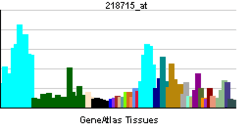UTP6
U3 small nucleolar RNA-associated protein 6 homolog is a protein that in humans is encoded by the UTP6 gene.[3][4][5]
See also
References
- ↑ "Human PubMed Reference:".
- ↑ "Mouse PubMed Reference:".
- ↑ Jenne DE, Tinschert S, Stegmann E, Reimann H, Nurnberg P, Horn D, Naumann I, Buske A, Thiel G (Jul 2000). "A common set of at least 11 functional genes is lost in the majority of NF1 patients with gross deletions". Genomics. 66 (1): 93–7. doi:10.1006/geno.2000.6179. PMID 10843809.
- ↑ Venturin M, Bentivegna A, Moroni R, Larizza L, Riva P (Sep 2005). "Evidence by expression analysis of candidate genes for congenital heart defects in the NF1 microdeletion interval". Ann Hum Genet. 69 (Pt 5): 508–16. doi:10.1111/j.1529-8817.2005.00203.x. PMID 16138909.
- ↑ "Entrez Gene: UTP6 UTP6, small subunit (SSU) processome component, homolog (yeast)".
Further reading
- Maruyama K, Sugano S (1994). "Oligo-capping: a simple method to replace the cap structure of eukaryotic mRNAs with oligoribonucleotides.". Gene. 138 (1-2): 171–4. doi:10.1016/0378-1119(94)90802-8. PMID 8125298.
- Suzuki Y, Yoshitomo-Nakagawa K, Maruyama K, et al. (1997). "Construction and characterization of a full length-enriched and a 5'-end-enriched cDNA library.". Gene. 200 (1-2): 149–56. doi:10.1016/S0378-1119(97)00411-3. PMID 9373149.
- Wang Y, Han KJ, Pang XW, et al. (2002). "Large scale identification of human hepatocellular carcinoma-associated antigens by autoantibodies.". J. Immunol. 169 (2): 1102–9. doi:10.4049/jimmunol.169.2.1102. PMID 12097419.
- Scherl A, Couté Y, Déon C, et al. (2003). "Functional proteomic analysis of human nucleolus.". Mol. Biol. Cell. 13 (11): 4100–9. doi:10.1091/mbc.E02-05-0271. PMC 133617
 . PMID 12429849.
. PMID 12429849.
- Strausberg RL, Feingold EA, Grouse LH, et al. (2003). "Generation and initial analysis of more than 15,000 full-length human and mouse cDNA sequences.". Proc. Natl. Acad. Sci. U.S.A. 99 (26): 16899–903. doi:10.1073/pnas.242603899. PMC 139241
 . PMID 12477932.
. PMID 12477932.
- Ota T, Suzuki Y, Nishikawa T, et al. (2004). "Complete sequencing and characterization of 21,243 full-length human cDNAs.". Nat. Genet. 36 (1): 40–5. doi:10.1038/ng1285. PMID 14702039.
- Gerhard DS, Wagner L, Feingold EA, et al. (2004). "The status, quality, and expansion of the NIH full-length cDNA project: the Mammalian Gene Collection (MGC).". Genome Res. 14 (10B): 2121–7. doi:10.1101/gr.2596504. PMC 528928
 . PMID 15489334.
. PMID 15489334.
- Andersen JS, Lam YW, Leung AK, et al. (2005). "Nucleolar proteome dynamics.". Nature. 433 (7021): 77–83. doi:10.1038/nature03207. PMID 15635413.
- Rual JF, Venkatesan K, Hao T, et al. (2005). "Towards a proteome-scale map of the human protein-protein interaction network.". Nature. 437 (7062): 1173–8. doi:10.1038/nature04209. PMID 16189514.
- Piddubnyak V, Rigou P, Michel L, et al. (2007). "Positive regulation of apoptosis by HCA66, a new Apaf-1 interacting protein, and its putative role in the physiopathology of NF1 microdeletion syndrome patients.". Cell Death Differ. 14 (6): 1222–33. doi:10.1038/sj.cdd.4402122. PMID 17380155.
- Douglas J, Cilliers D, Coleman K, et al. (2007). "Mutations in RNF135, a gene within the NF1 microdeletion region, cause phenotypic abnormalities including overgrowth.". Nat. Genet. 39 (8): 963–5. doi:10.1038/ng2083. PMID 17632510.

 . PMID 12429849.
. PMID 12429849. . PMID 12477932.
. PMID 12477932. . PMID 15489334.
. PMID 15489334.